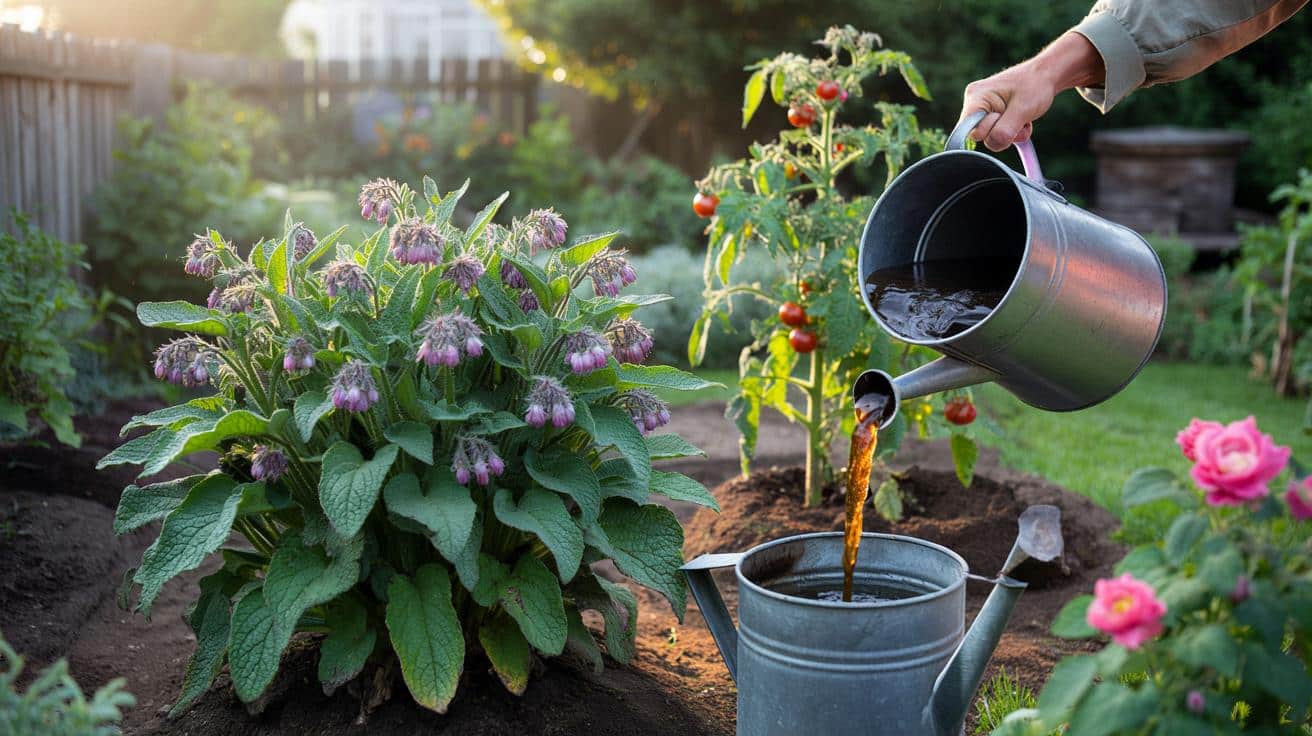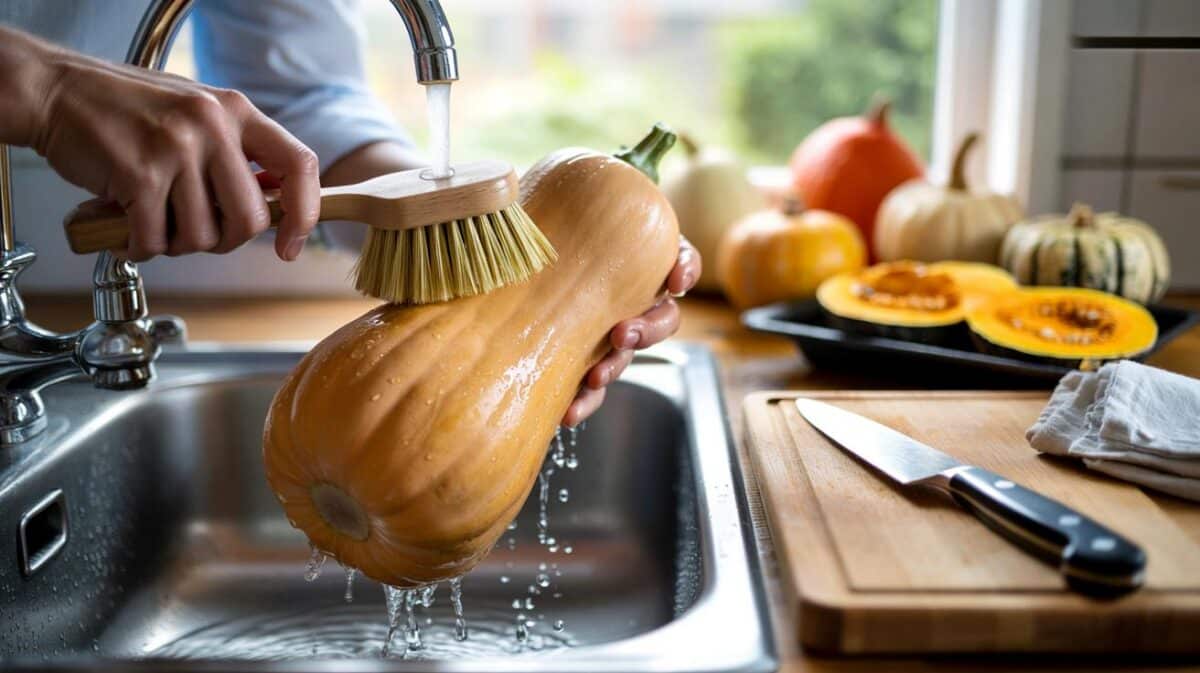Bags of feed stack up, watering cans go missing, borders sulk. What if one rugged plant could quietly do the heavy lifting — feeding the soil, drawing in bees, and stitching the whole space together?
I first met it at 7am behind a peeling fence in a London back garden. My neighbour, slippers and all, was stirring a black bucket with a stick like a witch at work, while bees needled in and out of purple bells above a mop of huge green leaves. She nodded at the plants and said, “Comfrey. It’s what keeps this place going.” She poured a tar-black brew into a watering can and walked the beds as if blessing them. A week later her roses looked like they’d been to the spa, and my sulking tomatoes perked up after a single drink. It smelled awful. It made everything sing.
The miracle plant hiding in plain sight: comfrey
Comfrey doesn’t glide into a garden with glamour. It arrives like a worker: thick leaves, sturdy stems, and bell-shaped flowers that bees don’t just visit — they queue for. After a wet day it seems to double in size, a soft green engine that pulses at the edge of a border. Plant it once and it becomes the quiet backstage crew to your show.
On a small terrace in Manchester, I watched a bare, tired strip turn lush in one season with a line of Bocking 14 comfrey tucked against a fence. The owner chopped the leaves and mulched her dahlias, then brewed a bucket of feed for tomatoes. Leaf analyses show comfrey is naturally rich in potassium, with useful nitrogen and calcium to boot. Those tomatoes didn’t just grow; they swaggered.
Here’s why it feels like magic. Comfrey pushes deep roots into the subsoil, hauling up minerals most plants can’t reach. When you chop the leaves and lay them down, you’re effectively recycling those nutrients at the surface. Soil life surges, worms drag the feast deeper, moisture lingers under the green mulch, and plants nearby respond. It’s a simple loop: root, harvest, return.
How to use comfrey like a pro (without letting it take over)
Start with the right variety: Bocking 14. It’s a sterile type, so it won’t seed all over. Plant root cuttings or young crowns in a spot you won’t need to disturb, in sun or light shade, with space for a clump about 60–90cm wide. Water it in, then forget about mollycoddling. Once established, cut the leaves when they’re big and lush, leaving the crown intact. Three to five cuts in a growing season is normal. That’s where the magic piles up.
For liquid feed, stuff a bucket with fresh comfrey leaves, weight them down with a brick, and leave the lid loosely on. In 2–4 weeks you’ll have a dark concentrate. Strain it, then dilute about 1:10 with water for general feeding, a touch weaker for seedlings. Don’t spill it on your shoes unless you enjoy the aroma of old socks. Use it on fruiting crops, roses, and hungry annuals. It’s a home-made tonic with the punch of shop feed.
Common mistakes? Planting common seeding comfrey in a border you plan to rework, then cursing it for years. Digging through a mature clump and scattering root fragments that sprout again. Overfeeding tomatoes so they go leafy instead of fruiting. We’ve all had that moment when the garden feels stubborn and silent — you don’t need fresh chaos on top. Go for Bocking 14, give it a fixed home, and chop, don’t churn. Let’s be honest: nobody does that every day.
Old allotmenteers will tell you this plant pays rent three times over. One head gardener put it neatly for me, nodding at a buzzing clump by his potting shed.
“Grow comfrey once and you’re basically minting your own feed. It’s the closest thing to a garden savings account.”
- Low effort, high reward: cut-and-drop mulch feeds beds without a compost heap marathon.
- Add leaves to the compost for faster, hotter heaps.
- Stack leaves under potatoes or courgettes as a slow-release layer.
- Free fertiliser: brew comfrey tea for fruiting crops, then watch the colour lift.
- Plant near bee-highways; it’s a plant it once, feed for years kind of ally.
The small leap that transforms a garden
If you’ve been eyeing your borders and feeling they’re missing a heartbeat, comfrey is that quiet metronome. It doesn’t ask for much and gives back in buckets — literally. Plant one clump behind the shed, another by the compost, and the rhythm starts: grow, cut, mulch, feed, repeat. A month later, foliage fattens, flowers come with more confidence, and the whole place feels steadier. You start noticing more bees. You notice soil that stays damp after a sunny day. The garden breathes easier, and, oddly, so do you. I’ve seen it steady new gardeners and give old ones a second wind. That’s the trick of a so-called miracle: it’s really just a simple habit you can live with — and it’s contagious in the best way.
| Point clé | Détail | Intérêt pour le lecteur |
|---|---|---|
| Choose Bocking 14 | Sterile, clump-forming, no self-seeding | All the benefits without the spread |
| Use three ways | Liquid feed, chop-and-drop mulch, compost activator | One plant, multiple boosts across the garden |
| Plant once, stay put | Give it a permanent corner and avoid digging it up | Easy care, fewer regrets, long-term payoff |
FAQ :
- Which comfrey should I plant?Bocking 14 is the go-to for gardens. It’s a selected strain that doesn’t set viable seed, so it stays where you put it.
- Will comfrey take over my plot?Not if you choose Bocking 14 and avoid chopping through roots when moving soil. Common seeding comfrey can wander, so skip that in small spaces.
- How do I make comfrey feed without the smell?The smell comes with fermentation. You can make a “cold soak” in a lidded container outdoors, or try a simple leaf mould: pack leaves into a porous bag, submerge in water for a week, then dilute. It still whiffs, just less.
- Can I grow comfrey in pots or on a balcony?Grow the plant in a deep container if you must, but it’s happier in the ground. You can still make mini-batches of feed by borrowing leaves from a friend or community garden.
- Is comfrey safe around veg beds and pets?It’s widely used around edibles because it feeds the soil, not the plate. Keep the concentrate away from pets and children, and wash hands after handling the brew. The plant isn’t for human eating.








